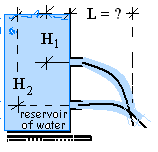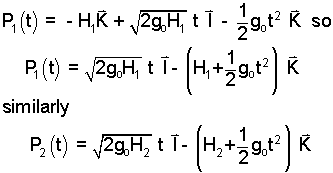| THERMO Spoken Here! ~ J. Pohl © | TOC NEXT ~ 236 |
Where Jets Collide
 The sketch shows a reservoir of water restrained by a wall.
The wall has two openings, one above the other. For the instant shown, jets of water that issue from the holes intersect at a distance, L, from the tank wall. Assuming the flow to be frictionless, the speed of each jet of water issuing from the wall outlet is given by Torricelli's Theorem.
The sketch shows a reservoir of water restrained by a wall.
The wall has two openings, one above the other. For the instant shown, jets of water that issue from the holes intersect at a distance, L, from the tank wall. Assuming the flow to be frictionless, the speed of each jet of water issuing from the wall outlet is given by Torricelli's Theorem.
Use the geometry to show that the intersection of streams occurs at the distance: L = 2 (H1 H2)1/2.
♦ We will treat the water not as a continuous flow but as a series of discrete droplets that are projected from each outlet. Our system is composed of two such droplets that collide at the presently unknown distance, L, from the wall.
Before we can write the "positions" of the two droplets, we must decide upon coordinates, origins and a vector basis. The setup needed is shown below right.
Notice the two red dots; they are our system, two droplets. Solutions of Newton's equations for projectile motion are:

An interesting aspect of this event is that the time scales, or clocks, that apply to the droplets that collide are distinct. The starting time and time of the droplets are not the same. Put otherwise, droplet 1 issues from the wall before does droplet 2. The droplets meet at an instant in time say, timpact but the times of the paths are different. Collision occurs when P1(t1*) = P2(t2*)
.


Where Water Jets Collide
 The sketch shows a reservoir of water restrained by a wall. The wall has two openings, one above the other. For the instant shown, jets of water that issue from the holes intersect at a distance, L, from the tank wall. Assume the flow frictionless, the speed of each jet of water issuing from the wall outlet is given by Torricelli's Theorem. Show intersection of streams occurs at distance: L = 2 (H1 H2)1/2.
The sketch shows a reservoir of water restrained by a wall. The wall has two openings, one above the other. For the instant shown, jets of water that issue from the holes intersect at a distance, L, from the tank wall. Assume the flow frictionless, the speed of each jet of water issuing from the wall outlet is given by Torricelli's Theorem. Show intersection of streams occurs at distance: L = 2 (H1 H2)1/2.
Premise presently unwritted!